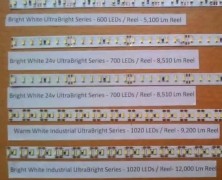When shopping for LED strip lights, you’ll regularly come across numbered terms such as 3020, 3528, and 5050. So what do these numbers mean, and why are they important in your buying process? This simple explanation will help you in understanding the different numbers used in LED strip lights. First, a basic understanding of how the strips themselves are constructed. The LED chips are mounted onto a thin, flexible metal strip that acts as a heat sink, drawing heat from the light chips and allowing them to remain cool during operation. This construction accounts for the “SMD” you’ll often see in strip light specifications, which stands for Surface Mount Device. The four-digit designation refers to the dimensions of the chip itself, in millimeters. A 3528 chip, for example, measures 3.5mm by 2.8mm, while a 5050 chip is 5.0mm by 5.0mm square. These different sizes dictate how many chips can be placed on a strip, which in turn determines its particular light qualities. Each has its benefits, so let’s break them down one at a time. The 5050 chips that Flexfire LEDs uses are actually composed of 3 light diodes, a construction sometimes referred to as a tri-chip. With 3 diodes, a 5050 chip will be brighter than other chips with one individual diode. But while a tri-chip is theoretically three times brighter, their larger size means fewer of them will fit onto a strip’s PCB (Printed Circuit Board). It also means they will generate more heat, requiring a thicker PCB to act as a heat sink. Finally, a tri-chip can be constructed with different types of diodes in the same chip, generating unique visual results. The three diodes can be combined to create millions of different color combinations, making them an excellent choice for...






